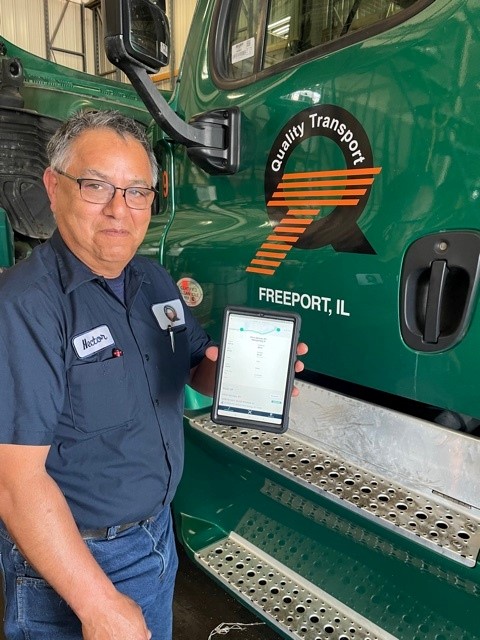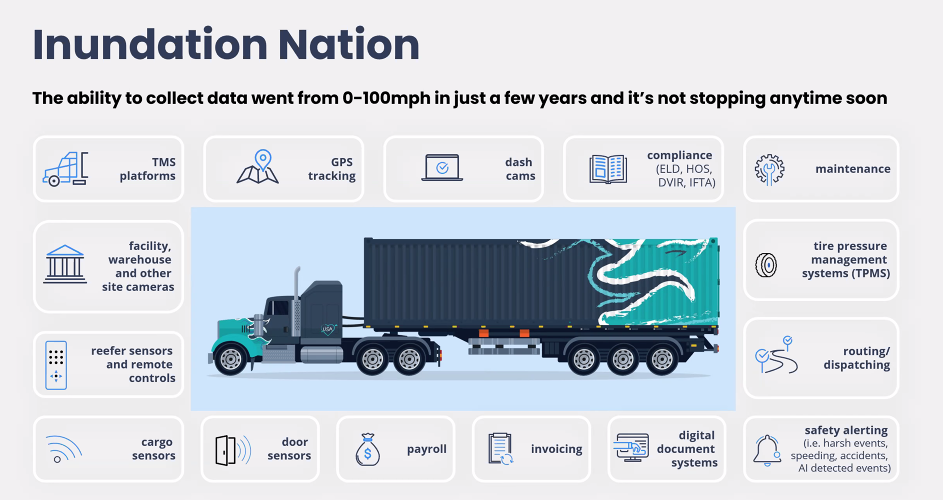Managing data overload
Amanda Schuier knew something had to change. She was sitting in her office, on the phone, poring through dozens of dashboards to make sense of the tsunami of data she found herself drowning in.
“I was living in the noise,” the senior vice-president of Quality Transport said during a Truckload Carriers Association webinar Thursday on managing data overload. “Every single day, I can’t do my job because I’ve got 36 dashboards telling what’s broken on the truck, when the driver is going to run out of hours, where their next dispatch is. It was frustrating me.”
It was also frustrating drivers who had to handle paperwork, and call dispatch for their next load after a delivery. They couldn’t plan their weeks because they never knew where they were going next.
The wheels had already been set in motion to simplify the fleet’s data collection and analysis methodology. The company was dissatisfied with its electronic logging device (ELD) provider, and wanted to integrate all the data it was collecting onto a single pane of glass. Then Covid hit. This actually sped up the process, Schuier said.
“It really accelerated our implementation,” she explained, because the company needed to pivot quickly to ensure everyone could work remotely. It also wanted to protect the safety of its staff, by eliminating paperwork. “It was almost a driving factor that pushed us to make these changes.”
The goal was to replace both the ELD supplier and the outdated transportation management system (TMS) the company was using, and to ensure the two data streams they generated could be seamlessly integrated. Schuier created a list of priorities. The systems had to be robust, but affordable for a small fleet. It had to support the fleet’s unique operations, had to allow it to do more with less, and ideally provide a “one stop shop” for data.
“I had in mind what our business needed,” Schuier said. “I had certain KPI [key performance indicator] metrics I wanted to be displayed.”

Robert Ramirez, head of sales for TMS supplier Axele, cautioned there is no silver bullet, so fleets should do as Schuier did, and create a checklist of what they want from a product.
“The ones that meet the most checkboxes, engage with them,” he suggested. Take advantage of free trials, experience the platforms first-hand and ask questions of the vendor to ensure they’re responsive, he added.
After deciding on a replacement ELD and TMS, Schuier said there was a two-pronged approach to implementation. For drivers, it was a crawl/walk/run approach. She started with three drivers as ELD beta-testers – two of them tech-savvy and enthusiastic, and one old school and cynical.
“I try to pick a proponent of the technology and then I always try to pick one who hates it and wants nothing to do with it,” she explained. “I know their feedback is going to be honest and sincere.”
The ELD was then rolled out to the over-the-road fleet first, then to local drivers. Drivers were soon getting their dispatches without having to call in, days in advance so they could plan their entire week. They were saving time by uploading documents rather than printing them.

The office staff, however, didn’t have the benefit of a gradual implementation. “The office staff was run/run/run. We needed to do it quickly because we were asking our drivers to do it,” she said. But the office staff adapted quickly because it was hungry for the changes, she added.
When bringing new technologies into the fleet, Schuier also said it’s important to walk the talk. When installing two-way cameras into the trucks, she also installed one in her minivan. It allowed her to gain first-hand experience with the technology while also proving to drivers that “I’m of the mindset that if I ask my drivers to do something, then I should do it myself.”
The next challenge was to consolidate data. Schuier said she wanted to bring together data related to accounting, billing, Hours-of-Service, driver settlements and the TMS onto one screen.
“We wanted to make our tasks faster and make the people we have more efficient.”
Ramirez cited a study that found it costs fleets about US$13 to process a single invoice due to inefficiencies that come with paper processing. Drivers were given tablets for receiving dispatch directions, and scanning and submitting paperwork. They could also use them to watch Netflix during downtime. Schuier believes the changes have contributed to reduced driver turnover.
Next, it was time to prioritize what to do with the data, now that it was better organized and consolidated.
“Start with small, measurable action items,” Schuier suggested. For Quality Transport, that meant revenue per mile/week and safety violations per month. “Start small and work up to it. In our previous life, we had data sources that weren’t agreeing on what the revenue per mile/week was and that’s pretty important when trying to run a business.”
In the future, Schuier plans to use data to right-size the fleet, improve efficiency, and identify dwell time at shippers and receivers. She also plans to integrate more maintenance-related data so it can be more proactive with repairs.
Have your say
This is a moderated forum. Comments will no longer be published unless they are accompanied by a first and last name and a verifiable email address. (Today's Trucking will not publish or share the email address.) Profane language and content deemed to be libelous, racist, or threatening in nature will not be published under any circumstances.